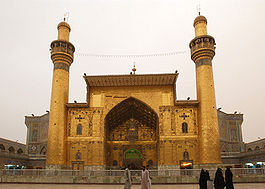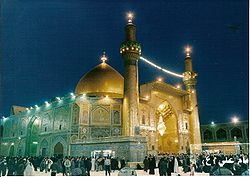- Imam Ali Mosque
-
Mosque / Shrine of Imam Ali 
Coordinates: 31°59′46″N 44°18′51″E / 31.996111°N 44.314167°ECoordinates: 31°59′46″N 44°18′51″E / 31.996111°N 44.314167°E Location  Najaf, Iraq
Najaf, IraqEstablished 977 Branch/tradition Shi'a The Imām ‘Alī Holy Shrine (Arabic: حرم الإمام علي), also known as Masjid Ali or the Mosque of ‘Alī, located in Najaf, Iraq, is the third holiest site for some of the estimated 200 million followers of the Shia branch of Islam. ‘Alī ibn Abī Tālib, the cousin of Muhammad, the fourth caliph (Sunni belief), the first Imam (Shia belief) is buried here. According to Shi'a belief[1] buried next to Ali within this mosque are the remains of Adam and Noah.
Contents
History
The shrine was first built by the Iranian ruler the Daylamite Fannakhosraw Azod ad Dowleh in 977 over the tomb of Ali. After being destroyed by fire, it was rebuilt by the Seljuk Malik Shah I in 1086, and rebuilt yet again by the Safavid Shah Ismail I shortly after 1500.
During the uprising of March 1991, following the Persian Gulf War, Saddam Hussein's Republican Guards damaged the shrine, where members of the Shia opposition were cornered, in storming the shrine and massacring virtually all its occupants. Afterwards the shrine was closed for two years, officially for repairs. Hussein also deported to Iran a large number of the residents of the area who were of Iranian descent. It is newly renovated by Dawoodi Bohras spiritual leader the 52nd dai mutlaq Dr. Syedna Mohammad Burhanuddin.(TUS)
Religious status
Part of a series on the Ali Life Family tree · marital life · Descendants
Succession to Muhammad
Birthplace · First Fitna
Timeline of Ali's life
Hadith of the pond of KhummLegacy Nahj al-Balagha · Qalam-e-Mowla
Zulfiqar · Imam Ali MosquePerspectives Ali the Warrior · Ali as Caliph
The Fourteen Infallibles
The Twelve Imams
Ali in the Qur'an
Sunni · Shi'aAs the burial site of Islam's second most important figure,[2] the Imām ‘Alī Mosque is considered by all Shias as the third holiest Islamic site[3][4][5][6][7][8] The Boston Globe reports “for the world's nearly 120 million Muslim Shias, Najaf is the third holiest city, behind Mecca and Medina in Saudi Arabia.[9][10][11] for some of the estimated 200 million followers of the Shī‘ah branch of Islām worldwide – approximately 15 percent of total Muslims. It is estimated that only Karbalā, Makkah and Madīnah receive more Muslim pilgrims.[12] A famous hadith mentions the site as one of "five definitive holy places that we respect very much".[13]
Precincts
Also buried within this mosque according to Shias are Prophet Adam[1][14] and Prophet Noah.[1][14]
The site is visited annually by at least 8 million pilgrims on average, which is estimated to increase to 20 million in years to come.[15]Many Shī‘ah believe that ‘Alī did not want his grave to be desecrated by his enemies and consequently asked his friends and family to bury him secretly. This secret gravesite is supposed to have been revealed later during the Abbasid caliphate by Ja‘far as-Sādiq, the Sixth Shī‘ah Imām.[16] Most Shī‘as accept that ‘Alī is buried in Imām ‘Alī Mosque, in what is now the city of Najaf (which grew around the shrine).[17]
It has also been narrated from Ja‘far as-Sādiq, the 6th Imām, that Imām ‘Alī Mosque is the third of five holy places: Makkah, Madīnah, Imām ‘Alī Mosque in Najaf, Imam Husayn Shrine in Karbalā, and the Shrine for Fātimah - daughter of Mūsā al-Kādhim in Qom.[18]
“ “God chose that land [Najaf] as the abode of the Prophets. I swear to God that no one more honourable than the Commander of the Believers [Ali] has ever lived there after (the time of) his purified fathers, Ādam and Nūh.”[19] ” Events in 2003-2006
Since the invasion of Iraq by the U.S. military in 2003, there have been a number of further attacks at the mosque:
- April 10, 2003, Shia leader Sayed Abdul Majid al-Khoei, the son of Grand Ayatollah Abu al Qasim al-Khoei, was killed near the mosque. Al-Khoei had returned from exile in Britain to encourage cooperation with the U.S.-led occupation of Iraq.
- August 29, 2003, a car bomb exploded outside the mosque just as the main Friday prayers were ending. Somewhere between 85 to 125 people were killed, including the influential Ayatollah Sayed Mohammed Baqir al-Hakim, the Shia leader of the Supreme Council for the Islamic Revolution in Iraq. The blast is thought to be the work of Abu Musab al-Zarqawi.
- May 24, 2004, unidentified mortar fire hit the shrine, damaging gates which lead to the tomb of Imam Ali.
- August 5, 2004, Muqtada al-Sadr and the Mahdi Army seized the mosque and used it as a military base for launching attacks against the Iraqi police, the provincial government and coalition forces. The fighting was eventually ended by a peace agreement. Although the neighboring buildings suffered considerable damage, the mosque itself suffered only superficial damage from stray bullets and shrapnel.
- August 10, 2006 a suicide bomber wearing an explosive harness blew himself up near the shrine, which killed 40 people and injured more than 50 others.
See also
- Holiest sites in Islam (Shia)
- Adam and Eve
- Noah
- Seven Laws of Noah
External links
- History of the Holy Shrine of Imam Ali (A.S.)
- GlobalSecurity.org website: past and current history of the mosque
- Mashhad Ali Amir al Muminin, An Najaf al Ashraf, Iraq
References
- ^ a b c al-Qummi, Ja'far ibn Qūlawayh (2008). Kāmil al-Ziyārāt. trans. Sayyid Mohsen al-Husaini al-Mīlāni. Shiabooks.ca Press. pp. 66–67.
- ^ Never Again! ShiaNews.com
- ^ Iran Diary, Part 2: Knocking on heaven's door Asia Times Online
- ^ Muslim Shia's Saint Imam Ali Holy Shrine - 16 Images Cultural Heritage Photo Agency
- ^ The tragic martyrdom of Ayatollah Al Hakim calls for a stance Modarresi News, September 4, 2003
- ^ Zaman Online, August 13, 2004
- ^ Never Again! ShiaNews.com
- ^ Why 2003 is not 1991 The Guardian, April 1, 2003
- ^ Iraqi forces in Najaf take cover in important Shia shrine The Boston Globe, April 2, 2003]
- ^ Religious rivalries and political overtones in Iraq CNN.com, April 23, 2003]
- ^ "Miscellaneous Relevant Links" Muslims, Islam, and Iraq]
- ^ Iraqi forces in Najaf take cover in important Shia shrine The Boston Globe, April 2, 2003]
- ^ Iran Diary, Part 2: Knocking on heaven's door Asia Times Online
- ^ a b http://www.al-islam.org/ziyarat/iraq.htm#Najaf
- ^ "Red tape curbs profits from Iraq religious tourism". Reuters. 2009-02-16. http://www.reuters.com/article/newsMaps/idUSTRE51F1ZH20090216?pageNumber=2&virtualBrandChannel=0&pageNumber=2&virtualBrandChannel=0. Retrieved May 9, 2009.
- ^ Majlesi, V.97, p. 246-251
- ^ Redha, Mohammad; Mohammad Agha (1999). Imam Ali Ibn Abi Taleb (Imam Ali the Fourth Caliph, 1/1 Volume). Dar Al Kotob Al ilmiyah. ISBN 2-7451-2532-X.
- ^ Escobar, Pepe (May 24, 2002). "Knocking on heaven's door". Central Asia/Russia. Asia Times Online. http://www.atimes.com/c-asia/DE24Ag04.html. Retrieved 2006-11-12. "To give a measure of its importance, according to a famous hadith (saying) - enunciated with pleasure by the guardians of the shrine - we learn that ‘our sixth imam, Imam Sadeg, says that we have five definitive holy places that we respect very much. The first is Mecca, which belongs to God. The second is Medina, which belongs to the Holy Prophet Muhammad, the messenger of God. The third belongs to our first imam of Shia, Ali, which is in Najaf. The fourth belongs to our third imam, Hussein, in Kerbala. The last one belongs to the daughter of our seventh imam and sister of our eighth imam, who is called Fatemah, and will be buried in Qom. Pilgrims and those who visit her holy shrine, I promise to these men and women that God will open all the doors of Heaven to them.’"
- ^ al-Qummi, Ja'far ibn Qūlawayh (2008). "10". Kāmil al-Ziyārāt. trans. Sayyid Mohsen al-Husaini al-Mīlāni. Shiabooks.ca Press. p. 67.
Mosques in Iraq  Abdul-Aziz al-Samarrai mosque • Abu Hanifa Mosque • Al-‘Abbās Mosque • Al ‘Askarī Mosque • Al Kādhimiya Mosque • Great Mosque of Kufa • Great Mosque of Samarra • Imām ‘Alī Mosque • Imām Husayn Mosque
Abdul-Aziz al-Samarrai mosque • Abu Hanifa Mosque • Al-‘Abbās Mosque • Al ‘Askarī Mosque • Al Kādhimiya Mosque • Great Mosque of Kufa • Great Mosque of Samarra • Imām ‘Alī Mosque • Imām Husayn Mosque
Wikimedia Foundation. 2010.


